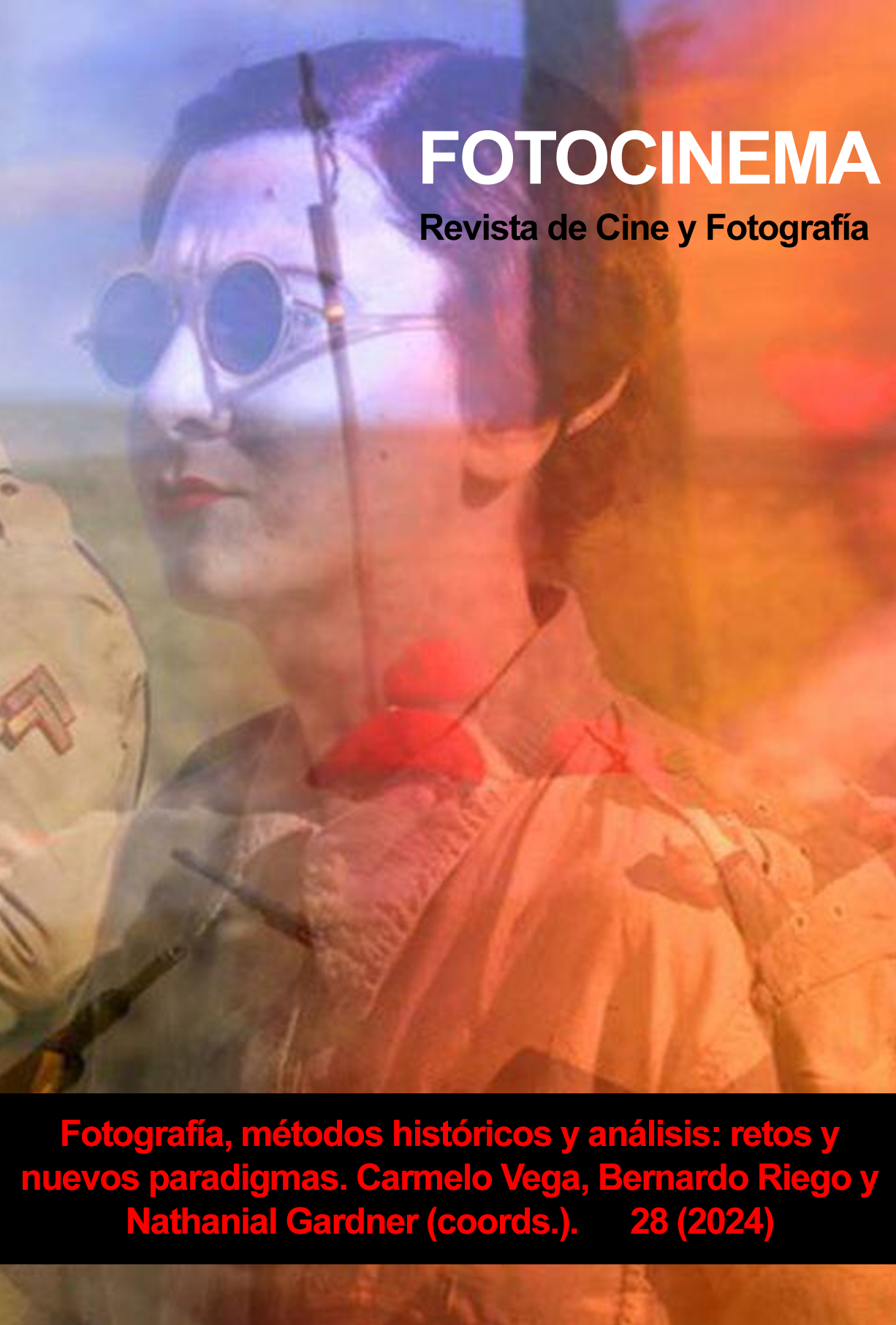Rethink photographic narratives: historiographical insights into Magnum Photos and the legacy of Sergio Larraín
DOI:
https://doi.org/10.24310/fotocinema.28.2024.17685Keywords:
Historiographical Reflections, Photography, Magnum Photos, Sergio Larraín, AestheticsAbstract
Photography, as a medium, has long been recognized for its unparalleled ability to capture and convey stories, with Magnum Photos standing as a testament to the profound influence of visual narratives on shaping global perceptions and historical interpretations. This essay delves deeply into the historiographical intricacies of Magnum and the enduring legacy of Sergio Larraín. It underscores the delicate interplay between objective documentation and the inevitable subjective interpretation that often accompanies powerful imagery. Larraín's distinct humanistic approach, which prioritized the intricate subtleties of human experiences amidst broader socio-political landscapes, frequently found itself juxtaposed, if not overshadowed, by Magnum's commercial and editorial imperatives. Such reframing not only alters the essence of the captured moment but also raises critical questions about the ethics of photojournalism and the overarching responsibilities of influential photographic agencies. In today's digital age, where the rapid dissemination of images can lead to widespread reinterpretation, the imperative for a more ethically grounded and transparent approach to photojournalism becomes even more pronounced. Through this exploration, the essay underscores the transformative power of photographs, emphasizing the importance of preserving the sanctity of the original vision while also acknowledging and respecting the myriad interpretations that such images can evoke.
Downloads
Metrics
References
Anderson, J. L. (2012). Magnum Revolution. London: Prestel.
Barthes, R. (1984). Camera Lucida: Reflections on Photography. London: Fontana Paperbacks.
Burke, E. (1823). A Philosophical Enquiry Into the Origin of Our Ideas of the Sublime and Beautiful. London: Thomas McLean. (Original work published 1757).
Castillo, M. d. (2018, May/September 12-9). Sergio Larrain na revista O Cruzeiro Internacional. Retrieved November 1, 2019, from IMS: https://ims.com.br/2016/05/04/sergio-larrain-na-revista-o-cruzeiro-internacional/
Chéroux, C. (2017). Magnum Manifesto. London: Thames & Hudson Ltd.
Donoso, J. (2004). El Escribidor Intruso. Santiago: Ediciones UDP.
Farago, J. (2014, May 20). Urbes Mutantes: Latin American Photography review – The revolution is inevitable. Retrieved October 30, 2019, from The Guardian: https://www.theguardian.com/artanddesign/2014/may/20/urbes-mutantes-latin-american-photography-review
Fielder, J. (n.d.). Winston Churchill. Retrieved November 5, 2019, from Yousuf Karsh, master photographer of the 20th century: https://karsh.org/photographs/winston-churchill/
Gibbs, N. (2016). 100 Photographs: The Most Influential Images of All Time. New York: Liberty Street. Retrieved November 9, 2020
Hoelscher, S. (2013). Reading Magnum. Austin: The University of Texas Press.
Jones, J. (2011, September 2). The meaning of 9/11's most controversial photo. Retrieved October 17, 2019, from The Guardian: https://www.theguardian.com/commentisfree/2011/sep/02/911-photo-thomas-hoepker-meaning
Lardinois, B. (2007). Magnum Magnum. London: Thames & Hudson Ltd.
Larraín, S. (1963). El Rectángulo en la Mano. Cuadernos Brasileiros.
Larraín, S. (1959, January 1). La Ciudad Colgada en los Cerros. Revista O Cruzeiro Internacional, pp. 92-95.
Larraín, S. (1960a, September 24). Je Reviens Du Bout Du Monde. Paris Match, pp. 68-75.
Larraín, S. (1959). [Algerian Farmer Roll Caption and Information (for NYT)]. Magnum Photos Paris (Sergio Larraín Series, Binder n5, Paris, France.
Leiva, G. (2012). Sergio Larrain: Biografia / estetica / fotografia. Santiago de Chile: Metales Pesados.
MagnumPhotos. (n.d.). Werner Bischof. Retrieved October 30, 2019, from Magnum Photos: https://bit.ly/3jyIW4n
MagnumPhotos. (n.d.). Overview. Retrieved October 16, 2019, from Magnum Photos: https://bit.ly/38s6gud
Manchester, W. (1989). In Our Time. Verona: Arnoldo Mondadori Editore.
Molocha, D. (2016, October 25). Susan Meiselas Photographs The Nicaraguan Revolution. Retrieved November 9, 2020, from Culture Trip: https://theculturetrip.com/central-america/nicaragua/articles/history-beneath-the-surface-susan-meiselas-photographs-of-the-nicaraguan-revolution/
Rich, F. (2006, September 10). Whatever Happened to the America of 9/12?. Retrieved October 17, 2019, from The New York Times: https://www.nytimes.com/2006/09/10/opinion/10rich.html
Ritchin, F. (2016). Magnum Photobook. London: Phaidon.
Sire, A. (2013). Sergio Larrain: Vagabond Photographer. London: Thames & Hudson.
Sontag, S. (2004). Regarding the Pain of Others. London: Penguin Books. (Original work published 2003)
TATE (n.d.). "Magnum Photos". Retrieved August 31, 2021, from TATE: https://www.tate.org.uk/art/art-terms/m/magnum-photos.
Downloads
Published
How to Cite
Issue
Section
License
Copyright (c) 2024 Jean Paul Brandt

This work is licensed under a Creative Commons Attribution-NonCommercial-NoDerivatives 4.0 International License.
All contents published in Fotocinema Revista científica de cine y fotografía are protected under the Creative Commons Attribution-NonCommercial-ShareAlike 4.0 International (CC BY-NC-SA 4.0) license. All about this license is available in the following link: <http://creativecommons.org/licenses/by-nc-sa/4.0>
Users can copy, use, redistribute, share and exhibit publicly as long as:
- The original source and authorship of the material are cited (Journal, Publisher and URL of the work).
- It is not used for comercial purposes.
- The existence of the license and its especifications are mentioned.
There are two sets of authors’ rights: moral and property rights. Moral rights are perpetual prerogatives, unrenounceable, not-transferable, unalienable, imprescriptible and inembargable. According to authors’ rights legislation, Fotocinema. Revista científica de cine y fotografía recognizes and respects authors moral rights, as well as the ownership of property rights, which will be transferred to University of Malaga in open access. The property rights are referred to the benefits that are gained by the use or the dissemination of works. Fotocinema. Revista científica de cine y fotografía is published in an open access form and it is exclusively licenced by any means for doing or authorising distribution, dissemination, reproduction, , adaptation, translation or arrangement of works.
Authors are responsable for obtaining the necessary permission to use copyrighted images.













13.png)




